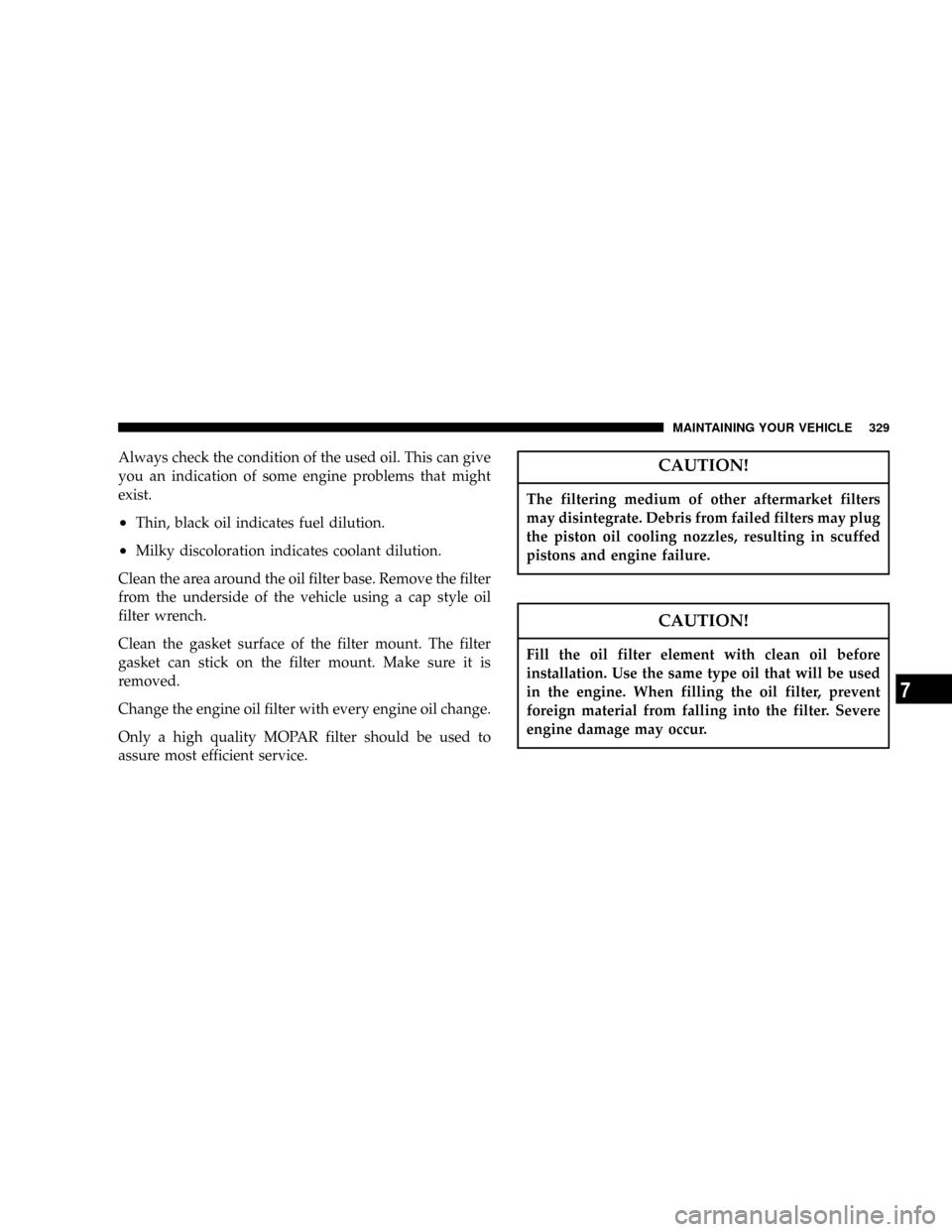Page 280 of 426
NOTE:
²These mirrors are power adjustable and heated.
²The passenger side main mirror is flat.
Cooling System Tips Ð Trailer Towing
To reduce potential for engine and transmission over-
heating, take the following actions in high ambient
temperatures:
²City DrivingÐwhen stopped, put the transmission in
N (Neutral) and increase the engine idle speed.
280 STARTING AND OPERATING
Page 281 of 426

²Highway DrivingÐreduce your speed.
²Air ConditioningÐturn it off temporarily.
²Hilly TerrainÐTurn overdrive off.
See Cooling System Operating information in the Service
and Maintenance section of this manual for more infor-
mation.
Automatic Transmission Oil Temperature Warning
Light
All vehicles with heavy duty transmission oil cooling are
equipped with a transmission sump oil temperature
sensor and warning light. If elevated transmission tem-
peratures are encountered, the engine controller will
select the most desirable gear until the transmission
temperatures are reduced. If transmission oil tempera-
tures continue to rise, a warning light located in theinstrument cluster will illuminate. If this should occur,
stop the vehicle, shift to Neutral, and run the engine at
idle or faster until the light goes off.
Towing With An Automatic Transmission
Vehicles equipped with an automatic transmission may
shift into and out of Overdrive, or a lower gear, when
driving in hilly areas, when heavily loaded, or when
towing into heavy winds.
When this condition occurs, press the ªTOW/HAULº
button or shift into a lower gear to prevent excessive
transmission wear and/or overheating, and to provide
better engine braking.
NOTE:Do not exceed the following RPM while manu-
ally downshifting:
²5.9L Diesel Engines 3200 RPM.
STARTING AND OPERATING 281
5
Page 318 of 426

NBody Lubrication.....................340
NWindshield Wiper Blades................341
NWindshield Washers...................341
NExhaust System......................342
NCooling System.......................343
NFan ...............................347
NCharge Air Cooler (Inter-Cooler)..........347
NHoses And Vacuum/Vapor Harnesses.......348
NBrake System........................348
NClutch Linkage.......................350
NClutch Hydraulic System................351
NPropeller Shaft Universal Joints...........351NRear Axle And 4X4 Front Driving Axle Fluid
Level..............................351
NTransfer Case Ð If Equipped.............352
NManual Transmission Ð If Equipped.......352
NAutomatic Transmission................353
NFront Wheel Bearings..................355
NSelection Of Lubricating Grease...........356
NNoise Control System Required
Maintenance & Warranty................357
NAppearance Care And Protection From
Corrosion...........................362
mFuse And Relay Center...................366
mVehicle Storage........................366
318 MAINTAINING YOUR VEHICLE
Page 324 of 426

²Do not use alcohol or gasoline as a fuel blending agent.
They can be unstable under certain conditions and be
hazardous or explosive when mixed with diesel fuel.
²If an engine has been operating and the coolant is hot,
allow the engine to cool before you slowly loosen the
filler cap and relieve the pressure from the cooling
system.
²To avoid burns, remember that the engine components
will stay hot after the engine is shut off.
²Do not use gasoline or other flammable materials to
clean parts. Always use approved cleaning solvents.
²Relieve all pressure in the fuel, oil and cooling systems
before any lines, fittings or related items are removed
or disconnected. Be alert for possible pressure when
disconnecting any device from a system that utilizespressure. Do not check for pressure leaks with your
hand. High pressure oil or fuel can cause personal
injury.
WARNING!
Do not open the high pressure fuel system with the
engine running. Engine operation causes high fuel
pressure. High pressure fuel spray can cause serious
injury or death.
²Important:All maintenance other than that listed in
this manual, as well as some procedures listed here,
MUSTbe performed by your local Dodge Truck
Dealer. Your authorized Dodge Dealer has been
trained and has the necessary parts to maintain your
engine.
324 MAINTAINING YOUR VEHICLE
Page 329 of 426

Always check the condition of the used oil. This can give
you an indication of some engine problems that might
exist.
²Thin, black oil indicates fuel dilution.
²Milky discoloration indicates coolant dilution.
Clean the area around the oil filter base. Remove the filter
from the underside of the vehicle using a cap style oil
filter wrench.
Clean the gasket surface of the filter mount. The filter
gasket can stick on the filter mount. Make sure it is
removed.
Change the engine oil filter with every engine oil change.
Only a high quality MOPAR filter should be used to
assure most efficient service.
CAUTION!
The filtering medium of other aftermarket filters
may disintegrate. Debris from failed filters may plug
the piston oil cooling nozzles, resulting in scuffed
pistons and engine failure.
CAUTION!
Fill the oil filter element with clean oil before
installation. Use the same type oil that will be used
in the engine. When filling the oil filter, prevent
foreign material from falling into the filter. Severe
engine damage may occur.
MAINTAINING YOUR VEHICLE 329
7
Page 343 of 426

Cooling System
Cooling System Maintenance
At the intervals shown in the Maintenance Schedules
Section of the manual, the system should be drained,
flushed and filled.
Inspection
Coolant protection checks should be made every 12
months (prior to the onset of freezing weather, where
applicable). If coolant is dirty or rusty in appearance, the
system should be drained, flushed and refilled with fresh
coolant as specified.
Inspect the entire cooling system for leaks. Check the face
of the radiator for any accumulation of bugs, leaves, or
other foreign matter. If dirty, clean the radiator core with
a garden hose. With the engine OFF, gently spray water
from the back of the radiator core. Check coolant bottle
tube for condition and tightness of connections at coolant
bottle and radiator.Check the coolant pressure cap and coolant bottle for
proper vacuum sealing. With the engine at normal oper-
ating temperature, note the level of the coolant in the
coolant bottle. Without removing the pressure cap (with
the engine off), drain a small amount of coolant from the
radiator drain cock. If the coolant level in the coolant
bottle drops, the system is sealing properly.
Extremely cold ambient temperature may require the
addition of a ªwinter frontº for effective operation of the
cab heating/cooling system. Make certain that a percent-
age of the radiator is exposed for adequate air flow
through the charge air cooler and automatic transmission
oil cooler. The percentage of opening must be increased
with the increasing ambient air temperature and/or
engine load. If the cooling fan can be heard cycling
frequently, increase the size of the opening in the winter
front.
MAINTAINING YOUR VEHICLE 343
7
Page 344 of 426

Coolant bottle level check
The coolant reserve system provides a quick visual
method of determining that the coolant level is adequate.
With the engine idling, and warmed to the normal
operating temperature, the level of the coolant on the
coolant bottle should be between the fluid level marks.
Check the coolant level whenever the hood is raised.
The radiator normally remains completely full, so there is
no longer a need to remove the coolant pressure cap
except for checking coolant freeze point or replacement
with new antifreeze coolant.
WARNING!
Never add coolant to the radiator when the engine is
overheated. Do not loosen or remove pressure cap to
cool overheated engine! The coolant is under pres-
sure and severe scalding could result.
Drain, Flush And Refill
At intervals shown on the Maintenance Schedules, the
system should be drained, flushed and refilled. Refer to
your dealer or consult a service manual for proper
procedures.
Adding Coolant
When adding coolant or refilling system, a 50% solution
of ethylene glycol antifreeze coolant in water should be
used. Higher concentrations (not to exceed 65%) are
required if temperatures below -34 ÉF (-37 ÉC) are antici-
pated. Use only high purity water such as distilled or
deionized water when mixing the water/antifreeze solu-
tion. The use of lower quality water will reduce the
amount of corrosion protection in the engine cooling
system. Please note that it is the owner's responsibility to
maintain the proper level of protection against freezing
according to the temperatures occurring in the area
where the vehicle is operated.
344 MAINTAINING YOUR VEHICLE
Page 345 of 426
NOTE:Mixing coolant types will decrease the life of the
engine coolant and will require more frequent coolant
changes.
When additional coolant is needed to maintain the
proper level, add the recommended concentration of
antifreeze and water to the overflow bottle. Do not
overfill.
NOTE:Failure to follow the antifreeze concentration
and replacement recommendations, or failure to use
antifreeze formulated to prevent corrosion of all cooling
system metals, may result in radiator plugging, overheat-
ing, or cooling system leaks such as in core hole plugs.WARNING!
Never add coolant to the radiator when the engine is
overheated. Do not loosen or remove pressure cap to
cool an overheated engine. The coolant is under
pressure and severe scalding could result.
Recommended Engine Coolant
Refer to Recommended Fluids, Lubricants and Genuine
Parts for the correct Fluid type.
MAINTAINING YOUR VEHICLE 345
7